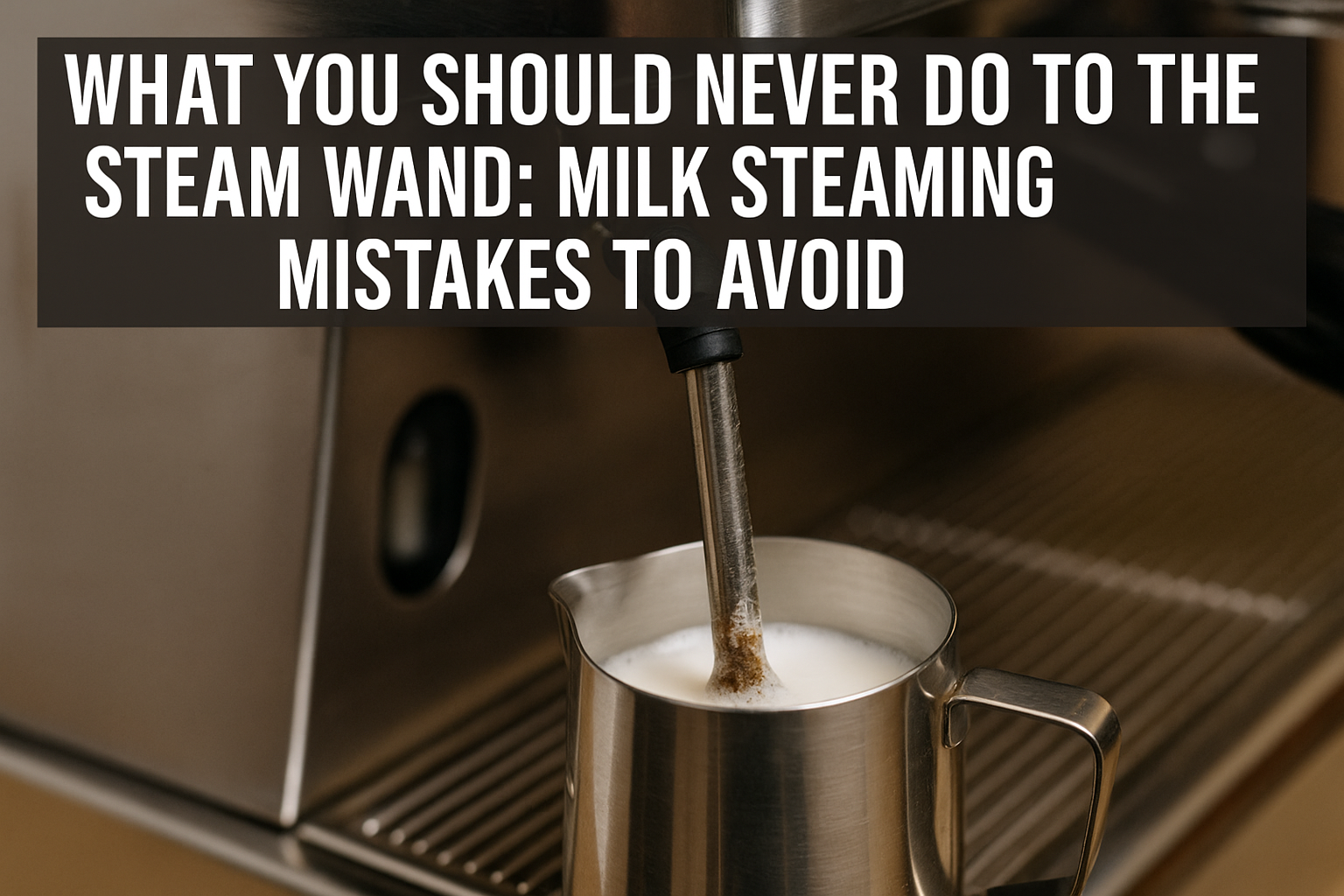If espresso is the heart of a coffee drink, then milk is its soul — especially in cappuccinos, lattes, and flat whites.
As a new barista, learning to steam milk properly is a major milestone. But along the way, it’s easy to pick up bad habits, especially when it comes to handling the steam wand.
This article covers the most common milk steaming mistakes beginners make, particularly those that involve misusing or neglecting the steam wand.
Not only do these mistakes affect taste and texture, but they can also create hygiene issues and damage equipment.
Let’s go through the key things you should never do — and what to do instead.
Never Skip Purging the Steam Wand
Purging means releasing a quick burst of steam before and after steaming milk. It may seem like a small step, but skipping it is a big mistake.
What happens if you don’t purge?
- Before steaming: Condensation builds up inside the wand. If you skip purging, cold water gets injected into your milk, ruining its texture and temperature.
- After steaming: Milk residue gets sucked back into the wand as the steam pressure drops. This causes clogs and creates a breeding ground for bacteria.
What to do instead:
- Always purge before and after steaming — every single time.
- Do it away from customers, preferably into a damp towel or the drip tray.
- Make it second nature. It’s not just about hygiene — it’s a mark of professionalism.
Never Leave Milk Residue on the Wand
This is one of the most visible rookie mistakes. If a customer sees crusty milk on the steam wand, they immediately question the cleanliness of the entire café.
Why it’s a problem:
- Burnt milk sticks to the wand if not cleaned right away.
- Residue leads to bacterial growth and unpleasant smells.
- Over time, milk hardens and becomes difficult to remove, affecting steam flow.
What to do instead:
- Wipe the wand immediately after steaming, using a clean, damp bar cloth.
- Don’t use paper towels — they disintegrate and don’t clean effectively.
- Change the cloth frequently throughout the shift and never let it dry out.
Clean tools = better drinks + more trust.
Never Submerge the Wand Too Deep (or Not Enough)
Where you place the tip of the steam wand in the milk jug is critical to creating the perfect texture. Beginners often go too deep (no air) or too shallow (too much air).
If you go too deep:
- You don’t introduce any air, so the milk stays flat.
- The result is hot milk, not microfoam.
- Drinks will lack texture and latte art becomes impossible.
If you go too shallow:
- You’ll inject too much air and create large, bubbly foam.
- The milk may splatter or make loud, screeching noises.
- The texture will be too dry and foamy, like for a cappuccino — even when that’s not what you’re making.
What to do instead:
- Start with the tip just below the surface to introduce air.
- Listen for a gentle “chirping” or “paper tearing” sound.
- Once the milk expands slightly, tilt the jug and submerge the wand deeper to create a vortex and polish the texture.
This two-stage method — stretching then spinning — is how you create silky, smooth microfoam.
Never Steam Milk Above 70°C (160°F)
Overheating milk is a classic beginner error. It ruins flavor and texture instantly.
What happens when milk gets too hot?
- Proteins break down and milk becomes thin or curdled.
- Natural sweetness is lost — replaced by a burnt, bitter taste.
- Customers will feel the difference, even if they don’t know why.
What to do instead:
- Aim for 60–65°C (140–150°F) — warm, but not scalding.
- Use a thermometer if you’re new or uncertain.
- With practice, learn the “hand test”: When the jug becomes too hot to touch for more than 1–2 seconds, it’s ready.
Remember: hot enough to enjoy, but never burn the milk.
Never Re-Steaming Old Milk
Another critical mistake: reusing milk that was already steamed, either to save time or reduce waste. It’s never acceptable — and most experienced baristas will call it out immediately.
Why it’s a no-go:
- Re-steamed milk develops a rubbery texture.
- It creates big bubbles and loses its sweetness.
- It poses a serious health risk, especially if milk has sat out.
- It reflects poorly on the café’s standards.
What to do instead:
- Only steam the amount of milk you need.
- Always use fresh, cold milk from the fridge.
- If you steam too much, discard the extra.
- Wasting milk is bad — but serving bad milk is worse.
Being efficient is great. Being careless is not.
Never Use the Wrong Pitcher Size
Pitcher choice affects milk texture more than most people think. Using the wrong size pitcher throws off your steaming game.
Common problems:
- Using a large pitcher for a small drink makes spinning the milk harder.
- Using a small pitcher for multiple drinks causes overflows and splashing.
- Wide pitchers without a spout make pouring difficult and imprecise.
What to do instead:
- Choose a pitcher that matches your drink volume (e.g., 12oz for lattes, 6oz for cortados).
- Fill the pitcher to just below the spout to leave room for stretching.
- Use a narrow spout pitcher for practicing latte art.
The right tools make your job easier — and your results better.
Never Ignore Steam Wand Positioning
Even if your milk steaming is decent, poor wand positioning can mess up the texture. Beginners often steam straight down into the milk, which creates a whirlpool — but not the kind you want.
What goes wrong:
- Steam goes directly to the bottom, creating too much heat and not enough movement.
- Milk spins unevenly or not at all.
- Texture becomes inconsistent with lumps or bubbles.
What to do instead:
- Angle the wand and pitcher slightly to one side.
- Position the wand off-center to create a smooth vortex.
- Adjust based on the jug and wand design — there’s no one-size-fits-all.
Always watch the motion of the milk — it should be spinning smoothly, like wet paint.
The Steam Wand Is a Tool — and a Responsibility
As a barista, the steam wand is one of the most powerful tools you have. But it requires respect. Misusing it affects the quality of your drinks and the hygiene of your station.
More importantly, customers notice. A beautiful latte with silky microfoam shows care. A flat or foamy mess says the barista didn’t pay attention.
Every time you steam milk, think:
- Did I purge the wand?
- Did I wipe it immediately?
- Is the milk fresh and cold?
- Am I listening to the sound and watching the texture?
These small habits separate amateurs from professionals.
Building Your Milk Steaming Routine
Here’s a reliable routine you can use every time:
- Pour cold milk into the right-size pitcher.
- Purge the steam wand.
- Position the wand tip just below the surface.
- Introduce air for 2–4 seconds.
- Submerge the tip and angle the jug to create a vortex.
- Watch the temperature — stop around 65°C.
- Turn off the steam before removing the wand.
- Wipe the wand immediately.
- Purge again.
- Swirl and tap the pitcher before pouring.
Repeat this process every time — even when it’s busy. Consistency builds muscle memory and leads to silky, sweet, perfectly textured milk.
Final Thoughts: Treat the Wand with Respect
Every part of the coffee-making process matters, but steaming milk is where a lot of beginners get lazy. Don’t let that be you.
The steam wand is not just a tool — it’s a reflection of your attention to detail. It tells your customer, your manager, and your fellow baristas how seriously you take your role.
Clean it. Respect it. Learn it.
And most importantly, never stop improving.

Marcelo Rodrigues is a passionate barista with over 7 years of experience in specialty coffee. He’s worked in top cafés, led barista training sessions, and now shares practical tips to help beginners and coffee lovers improve their skills. Through this blog, Marcel makes the world of coffee more accessible—one cup at a time.

